

Mozambique
Tuesday 15-08 (385 km)
We leave the Kara O’Mula guest house in Mulanje early in the morning and drive 30 tarmac kilometres to the Mozambique border. Within 30 minutes we are all cleared on the Malawi side and continue our trip to the Mozambican border post. Here too, people are helpful and friendly and within less than an hour we have cleared immigration and customs. Half an hour later, just outside Milange, we hit the gravel road to Mocuba. The road is passable but severely corrugated and glancing at Paul’s face, I see that he is worried about Wa Bashasha. Still, she keeps running smoothly and almost 4 hours later we arrive – covered with fine red dust and sand and severely shaken – in Mocuba. For about an hour we have the illusion that the rest of the trip will be easy, but then the tarmac suddenly ends and we find ourselves on a horribly bad dirt road again. So far, Mozambique makes a much poorer impression than Malawi. People are dressed shabbily, outside the cities there are very few market activities, stone houses are rare and in a dilapidated state. Now and then we pass former Portuguese trading posts, all burned out and shot to pieces to be never rebuilt. Just before dark we enter Quelimane and see the Indian Ocean again. Quelimane, the fourth biggest city of Mozambique, is in advanced state of decay: potholed streets, many houses in ruins, others very badly maintained. Apparently there is a congress of sorts and we do not manage to find a place to stay. Eventually we end up in the Residentia Munazi where we pay 50 US$ per person for two beds! The guesthouse belongs to a high official in Maputo and we wonder how he gets away with ripping off his customers.
Wednesday 16-08 (285 km)
Glad to leave Residentia Munazi and Quelimane, we make our way to Mopeia and then hit a terrible hard mud track to Luabo. We arrive there, thoroughly shaken, after some six hours. We are all silent when Wa Bashasha rolls through the grass and finally comes to a halt in front of the burned out ruins of what, 32 years ago, was our colonial residence. We are prepared, but not enough. Along the rough track leading from Mopeia to Luabo, there had been the occasional burned out house, its walls pocked with machine gun fire holes and grenade hits. Shortly before we reached our old house, we passed the post office which had received a direct hit from a heavy howitzer grenade and the completely bombed out factory. Yet, the ruins of what once was our home almost take our breath. Paul jumps out of the car. From nowhere, there appears a Mozambican with a small diary who inquires whether Paul is Engenheiro Lapperre, the former Senior Agronomist of Sena Sugar Estates. We all get out of the car and are greeted like old friends. The Mozambican turns out to be Fernando Tomas, the man in charge of the guesthouse in Luabo. We only see burned out and plundered ruins, but when we look closer, there are three in tact houses hidden behind palm trees. The guest house, as it turns out, is the old residence of Bill and Ann Eyre and five minutes later we are shown around. The kitchen, dining room and veranda, with some dilapidated chairs, are still more or less functional. In the sitting room stands one made bed. Upstairs there is a made bed in each of the bedrooms and the bathroom sports a shower and a flush toilet with seat. Not filthy, but not clean either. Whilst we unload some of our luggage and food supplies, a chap is sent to fetch petrol to try and get the water pump going. Again from nowhere, an elderly woman appears. She is designated to cook and clean for us. Later we learn that her name is Maria. A man called Sebastiao is her aged helper. When Paul walks out of the house to fetch more of our luggage, a very old man rushes towards him and turns out to be Zecke, his old chief messenger boy. It is an emotional moment, particularly when Zecke discovers me and throws himself in the dust in front of me. Half an hour later, I feel like acting a role in the movie about my own life.
By candle light, and assisted by Maria, I am cooking dinner in Ann Eyre’s kitchen. Maria lays the table - a white table cloth with a burn hole in it and some crockery from bygone times - and Paul opens our last remaining bottle of wine. In the dining room where we were guests at least two dozen of times between 1965 and 1975, we eat traditional Dutch hutspot (meshed potatoes, carrots and onions) supplemented by the last tinned Vienna sausages from our emergency food box. Suddenly there is the roar of a generator some distance away and the single dangling bulb on the ceiling comes on. From Maria we learn that there is light every evening from 18.00 – 20.00 hours for a dozen or so households. Bulbs are apparently at a premium: our bedroom is still dark and so is the veranda. After dinner, here we sit for a while - more reflective than talkative – and then turn in completely exhausted.
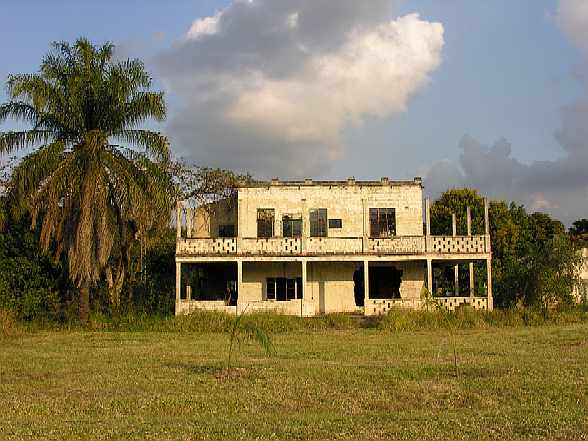
Paul and Meta's former home in Luabo
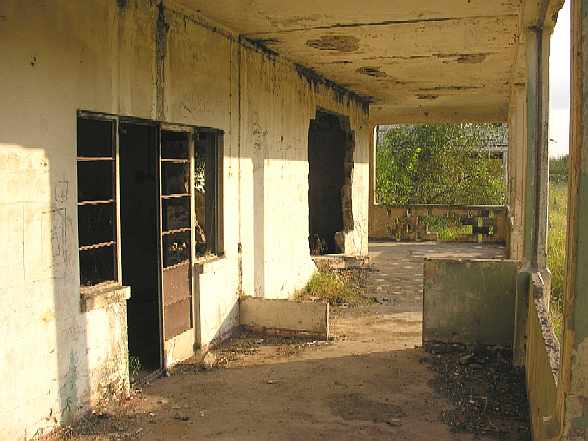 -
-
This is what is left of the veranda
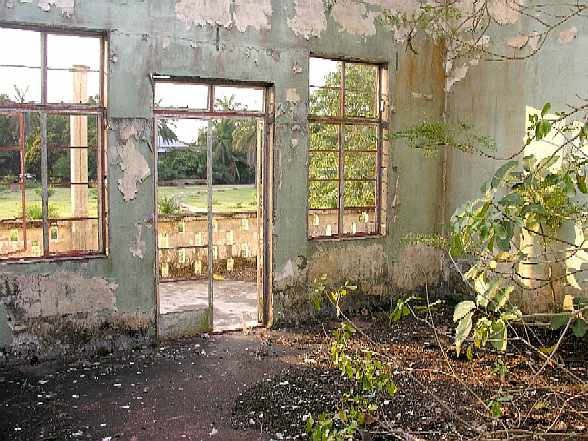
Paul and Meta's former bedroom
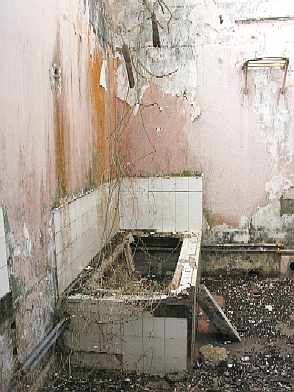
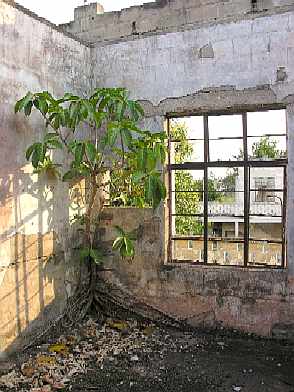
The former bathroom (left picture) and bedroom of their daughter Barbara (right picture)
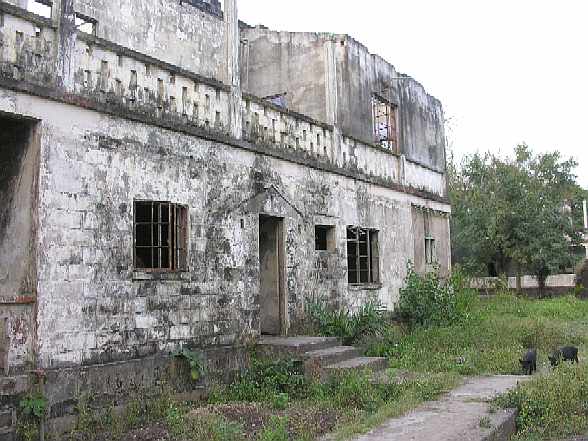
The backside of the house
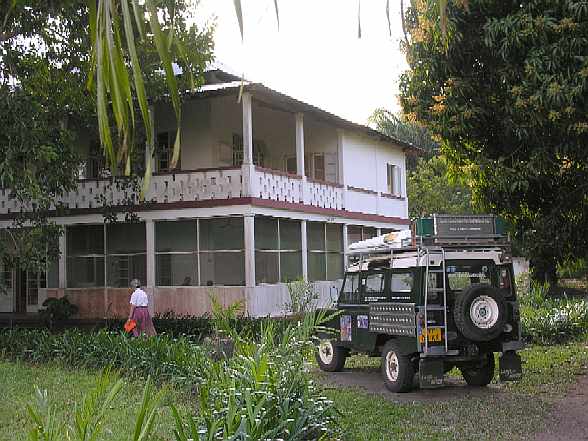
This house belonged to the Eyre Family, it now serves as the Luabo "guesthouse"
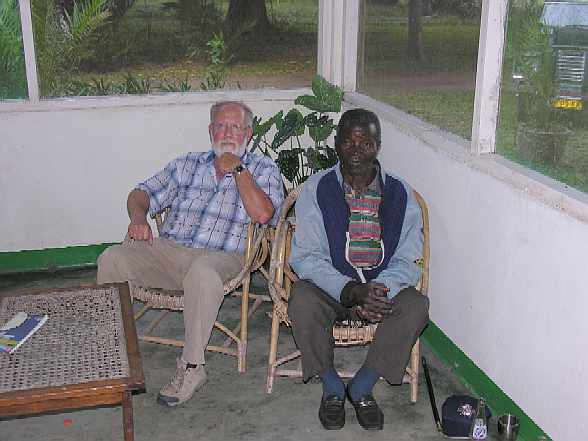
Paul with Zecke
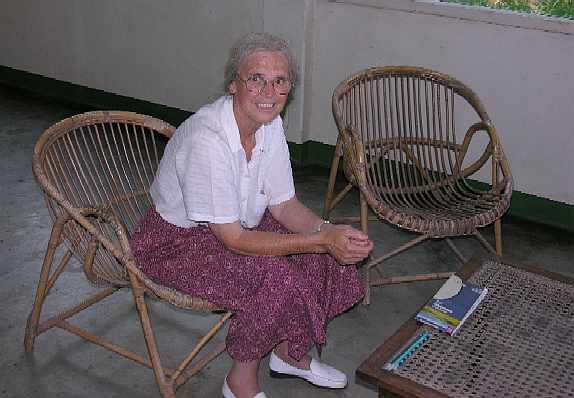
Meta's makes an unexpected discovery...
They are sitting on Meta's old chairs from her student home:
50 years ago these chairs were shipped from Amsterdam to Luabo.
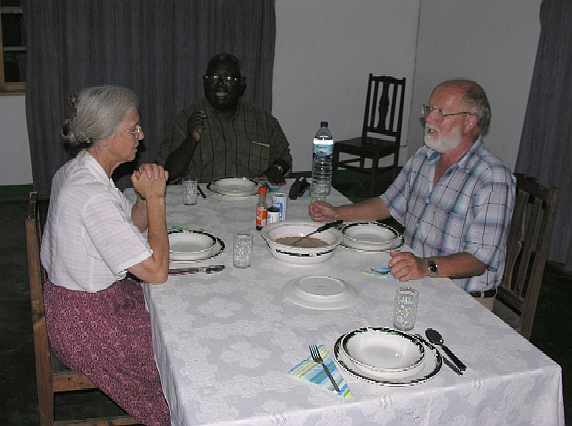
That evening Meta, Remigius, Paul and Roald have diner at the Luabo guesthouse
using the brought along soup, "hutspot" and sausages.
Thursday 17-08 (50 km)
I wake up from the sound of dish washing and the chatter of Maria and Sebastiao downstairs in the kitchen. Again I have the feeling of acting in a movie of my own life: the very sounds are those I heard every morning when we first lived in Luabo more than 40 years ago. I look for Paul, but he has apparently already showered and dressed. When I come down stairs there is the customary “bom dia, senhora” and I find Paul talking to old man Zecke who just brings some fresh fruits of the season for breakfast. Then two other old men appear: two of Paul’s former headmen. Roald and Remigius have also woken up and it is almost 09.30 hours before we are all gathered at the breakfast table. After breakfast we drive and walk around in what once was the pearl of the Zambezi Province: Sena Sugar Estate in Luabo. For most of the time we walk in silent horror. Some houses - like our old house - were apparently attacked with small arms and grenades and then put to fire. Later, every single item of value must have been plundered. What still stands, is a roofless skeleton of thick walls and steel reinforced ceilings. In our old bedroom, on the second floor, grows a Ficus tree. The dining room is in use as a public toilet. Some houses were only plundered and then left to rot. Some - like the house of Ton and Sjaan - have simply disappeared into the bush again and we are not able to locate it anymore. Streets are overgrown and it is only because we know Luabo so well, that we can find our way. Suddenly we stand in front of the hospital and for those that have never seen it in the old days, it is really hard to believe that it was once well equipped, clean, white washed and with light and running water. I almost weep. From one side, the building shows some machine gun and grenade damage and some rooms burned. This includes the room I gave birth to two of my children. Otherwise the building is still in tact but is incredibly filthy. Except in the office of the medical assistant - a doctor has not been seen in the hospital for almost two decades - there is not a single item of furniture or sanitary to be found. Upstairs, the medical assistant keeps his vaccines. Some of them in a derelict paraffin freezer, others just in boxes against the wall. On the Day of Judgement, both Frelimo and Renamo leaders alike have a lot to account for and somehow I hope He will not show any mercy. Since we have run completely out of supplies, we drive back to the guesthouse, pick up Maria and pay a visit to the Luabo market. Passing the bombed post office again and the burned out Donna Anna’s place, where we used to eat seafood in the past, we find the market where it had been 40 years ago. There is a good supply of dried fish, vegetables, salt, cooking oil and many other essentials. The prices, however, are staggering and we wonder how on earth people manage. We buy some macaroni, dried beans, bottled water and even manage to find a tin of Baygon insect spray and two bottles of Amstel lager! Whatever we buy, I buy for Maria too. Suddenly a man in his early forties addresses Paul, who reacts as if he sees a ghost. It is the eldest son of Pauls’s former chief laboratory analyst – Santos Bachor – and he is the spitting image of his father who died in 1974 in Luabo when we were still there. Paul asks him to come to the guesthouse later for a chat.
For lunch, Maria cooks bean soup and after lunch we drive to Paul’s old place: the “Laboratorio do Campo” or the Field Laboratory. I somehow wished I could have spared Paul the sight. The buildings are still there but have been completely ransacked and burned. The tiled concrete laboratory tables in the analysis room still stand, but are covered with human shit. The meteorological station is overgrown and so are the cane treatment tanks. We take some photographs and leave: it is a sight one does not really want to remember. For some time we drive along what once used to be the main irrigation canal. It is dry and almost unrecognisable as such and people are now growing vegetables in it. Suddenly we meet a Nissan pick-up with metal scrap and it becomes apparent that scrap dealers are collecting whatever is left in the fields: railway tracks, old steam ploughs, parts of Priestman tiger cranes, chains and railway trucks. Maybe all this is symbolic for development: “… dust to dust and ashes to ashes”. Back in Eyre’s house we talk to the people that have come to see us.
Apparently the Luabo sugar factory functioned until 1985, 10 years after we left, when Renamo fighters attacked it. Damage was done to the factory but the Frelimo administration, and the East Germans working in Luabo, managed to carry out the necessary repairs. The end came when Renamo attacked again in 1988. The housing area and the factory were repeatedly hit by heavy howitzer grenades from the other side of the river and when Renamo infantry charged, they overran the government forces in a matter of hours. According to the men we speak to, many government soldiers were killed in house to house fighting, after which Renamo began to execute hundreds of civilians, including East German expatriates. Those who could, fled by road to Chinde and stayed there until the end of the civil war in 1991.
Late in the afternoon, we visit the Sena Sugar Estate Head Office in Luabo. Apparently, Frelimo forces tried to defend it: some walls are covered with bullet holes and the rear of the building has grenade damage. The main structure, however, is still in tact and the building could be rebuilt. Our guide takes us to a small strong room and when the keys are found and the door is opened, we find two bronze statues: that of the founder of Sena Sugar Estates, the Englishman John Hornung, and that of the Portuguese dictator Antonio Salazar. The statues are the only items that were not looted from the site. Probably no one had a use for them.
That night we try to reassemble our thoughts. Luabo once was a modern, irrigated and successful sugar cane plantation with modern facilities: an electricity plant, safe piped water, workshops, a hospital, sport facilities, many small shops and a lively harbour. It provided direct employment for some 5000 people and some 40.000 people must have relied on Sena Sugar for their lively hood. The estate generated an important commodity for Mozambique, sugar, and provided the state with income. Agricultural research was carried out and its results were published in international journals. People were relatively healthy and well looked after. Now, Luabo is a place in the last stages of decay and in another 10 years time it is likely to be overgrown by the bush again. The entire infrastructure, including access roads, has collapsed. With very few exceptions, houses are left to rot. The people of Luabo are without hope. Some, however, (Renamo and Frelimo dignitaries, local entrepreneurs?) must have become very rich. Every single item of value was looted. Machinery, spare parts, cars, air conditioners, hospital equipment, furniture, appliances, etc. etc. When we finally turn in our second night in Luabo, we are all more than a little depressed.
Friday 18-08 (310 km)
In the morning we say farewell to Maria, Sebastiao, Zecke, the son of Santos and the manager of the guesthouse and we feel guilty to leave them behind in a place without hope. Silently we drive the horrible road back to Mopeia and then head for Zalala, some 30 km north of Quelimane. We arrive there early in the afternoon and, to our surprise, manage to hire a small weekend bungalow for two nights. Since there are only two beds, Roald sleeps in the roof tent. Zalala is situated on the Indian Ocean and at the far end of what once used to be large coconut plantations. In Portuguese times it used to be an attractive seaside resort and with some imaginations remnants of the infrastructure can still be recognized. Our weekend house, we find out later, was built by Sena Sugar Estates in 1958. Now it is owned by a successful business man in Quelimane. We have dinner in a tiny beach restaurant and for the first time in 32 years we eat charcoal grilled prawns and fish. We hope the beer will kill all the bugs!
Saturday 19-08 (0 km)
We have a lazy day, walking the beach, watching the fishermen, sitting in the sun and eating seafood. In the afternoon there is an incident when an Indian family arrives and claims they have hired and already paid our house for the weekend. They don’t blame us, but are, understandably, mad at the owner. He and his wife show up when we have dinner and they apologize for the upheaval. We have a delicious dinner again at our beach restaurant and then turn in.
Sunday 20-08 (410 km)
We drive back the same horrendous roads we took on our way into Mozambique and hope to arrive before dark at the Mozambique-Malawi border at Milange. Some 150 km from Milange, Paul suddenly brakes, stops on the corrugated gravel road and informs us that one of the rear spring aircushions has blown out. The car sags to the right and particularly in sharp bends it is difficult to keep Wa Bashasha on the road. We slowly limp back to Milange. Just before closing time we arrive at the border where we pass immigration and customs without further difficulties. Another half-an-hour tarmac road and we are back at the Kara O’Mula guesthouse in Mulanje.
We are dead-tired and once under the shower, the drain almost clogs up when all the Mozambique dust turns into mud. At dinner we once again talk Mozambique and come to the conclusion that it will take weeks, if not months, to order our thoughts and to write down our experiences. Still, before we go to bed, we raise our glasses for a “Viva Mozambique”.
© 2005-2006 Paul and Meta Lapperre - Website by MvS
